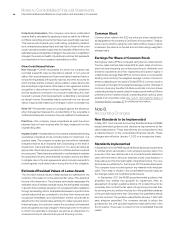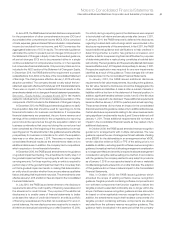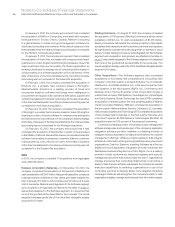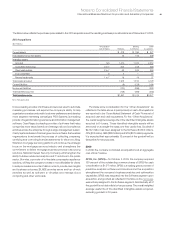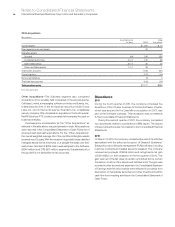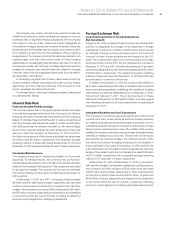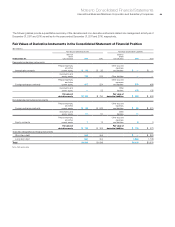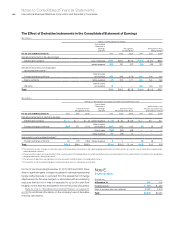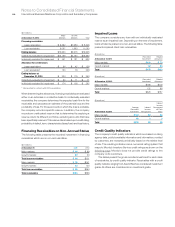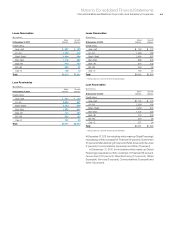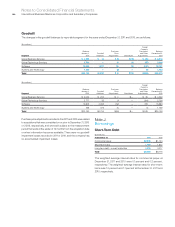IBM 2011 Annual Report Download - page 98
Download and view the complete annual report
Please find page 98 of the 2011 IBM annual report below. You can navigate through the pages in the report by either clicking on the pages listed below, or by using the keyword search tool below to find specific information within the annual report.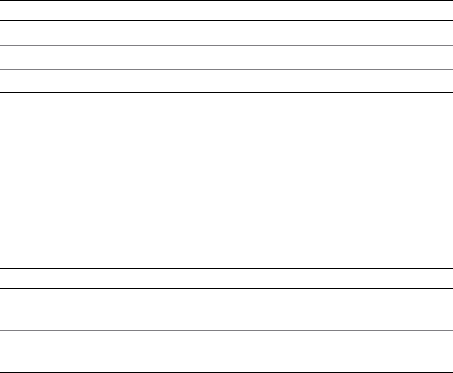
Notes to Consolidated Financial Statements
International Business Machines Corporation and Subsidiary Companies96
Based on an evaluation of available evidence as of December 31, 2011,
the company believes that unrealized losses on debt and marketable
equity securities are temporary and do not represent an other-than-
temporary impairment.
Sales of debt and marketable equity securities during the period
were as follows:
($ in millions)
For the year ended December 31: 2011 2010 2009
Proceeds $405 $16 $ 24
Gross realized gains (before taxes) 232 6 3
Gross realized losses (before taxes) (0) (0) (40)
The after-tax net unrealized holding gains/(losses) on available-for-
sale debt and marketable equity securities that have been included
in other comprehensive income/(loss) for the period and the after tax
net (gains)/losses reclassified from accumulated other comprehensive
income/(loss) to net income were as follows:
($ in millions)
For the year ended December 31: 2011 2010
Net unrealized gains/(losses)
arising during the period $ (7) $51
Net unrealized (gains)/losses
reclassified to net income* (143) (0)
* Includes writedowns of $0.3 million and $3.6 million in 2011 and 2010, respectively.
The contractual maturities of substantially all available-for-sale debt
securities are less than one year at December 31 , 2011.
Derivative Financial Instruments
The company operates in multiple functional currencies and is
a significant lender and borrower in the global markets. In the normal
course of business, the company is exposed to the impact of interest
rate changes and foreign currency fluctuations, and to a lesser extent
equity and commodity price changes and client credit risk. The
company limits these risks by following established risk management
policies and procedures, including the use of derivatives, and, where
cost effective, financing with debt in the currencies in which assets
are denominated. For interest rate exposures, derivatives are used
to better align rate movements between the interest rates associated
with the company’s lease and other financial assets and the interest
rates associated with its financing debt. Derivatives are also used
to manage the related cost of debt. For foreign currency exposures,
derivatives are used to better manage the cash flow volatility arising
from foreign exchange rate fluctuations.
As a result of the use of derivative instruments, the company is
exposed to the risk that counterparties to derivative contracts will
fail to meet their contractual obligations. To mitigate the counterparty
credit risk, the company has a policy of only entering into contracts
with carefully selected major financial institutions based upon their
credit ratings and other factors. The company’s established policies
and procedures for mitigating credit risk on principal transactions
include reviewing and establishing limits for credit exposure and
continually assessing the creditworthiness of counterparties. The
right of set-off that exists under certain of these arrangements
enables the legal entities of the company subject to the arrangement
to net amounts due to and from the counterparty reducing the
maximum loss from credit risk in the event of counterparty default.
The company is also a party to collateral security arrangements
with most of its major counterparties. These arrangements require
the company to hold or post collateral (cash or U.S. Treasury securities)
when the derivative fair values exceed contractually established
thresholds. Posting thresholds can be fixed or can vary based on
credit default swap pricing or credit ratings received from the major
credit agencies. The aggregate fair value of all derivative instruments
under these collateralized arrangements that were in a liability position
at December 31, 2011 and 2010 was $131 million and $363 million,
respectively, for which no collateral was posted at December 31, 2011.
The company posted collateral of $9 million at December 31, 2010.
Full collateralization of these agreements would be required in the
event that the company’s credit rating falls below investment grade
or if its credit default swap spread exceeds 250 basis points, as
applicable, pursuant to the terms of the collateral security arrangements.
The aggregate fair value of derivative instruments in net asset
positions as of December 31, 2011 and 2010 was $1,300 million and
$1,099 million, respectively. This amount represents the maximum
exposure to loss at the reporting date as a result of the counterparties
failing to perform as contracted. This exposure was reduced by
$324 million and $475 million at December 31, 2011 and 2010,
respectively, of liabilities included in master netting arrangements
with those counterparties. Additionally, at December 31, 2011 and
2010, this exposure was reduced by $466 million and $88 million
of collateral, respectively, received by the company.
The company does not offset derivative assets against liabilities
in master netting arrangements nor does it offset receivables or
payables recognized upon payment or receipt of cash collateral
against the fair values of the related derivative instruments. No
amount was recognized in other receivables at December 31, 2011
for the right to reclaim cash collateral. At December 31, 2010,
$9 million was recognized in other receivables for the right to reclaim
cash collateral. The amount recognized in accounts payable for
the obligation to return cash collateral totaled $466 million and
$88 million at December 31, 2011 and 2010, respectively. The company
restricts the use of cash collateral received to rehypothecation, and
therefore reports it in prepaid expenses and other current assets
in the Consolidated Statement of Financial Position. No amount
was rehypothecated at December 31, 2011. At December 31, 2010,
$9 million was rehypothecated.


